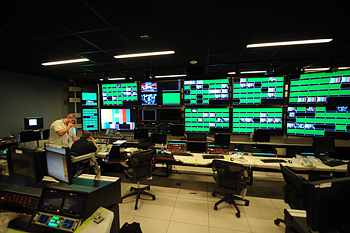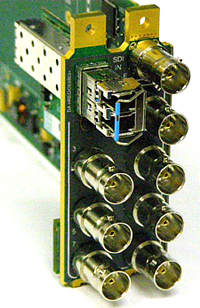Speed Bumps on the Road to 3G
WASHINGTON
Broadcast technology seems to be changing more rapidly with every passing year. Many engineers who sat on the sidelines when digital infrastructure technologies first began to emerge quickly discovered once they got in the game that they were not just making the jump from analog to digital, but in many cases all the way to HD. For those who did jump in early, they were quickly frustrated by the fact that their digital infrastructure was not future proof, could not readily handle new HD signals, and even worse—it had to be completely rebuilt.
One of the most enlightening illustrations regarding the leap in digital technologies comes from Dean Rosenthal, market manager for Broadcast and MSO Connectivity at ADC. In a presentation he gives to engineers who are thinking about upgrading their plant's infrastructure, Dean says "that for every signal type from analog to HD video, there is a limit to the size of the connectors that can be used. Basically, when a connector is longer than a quarterwavelength at the frequency it is operating, the signal will begin to degrade."
In the days of analog video, connector size was never a big issue. The math on an NTSC signal works out to be about 59 feet for the connector, (yes you read that right). The connector could be about 59 feet in length.
This dramatically changed with the introduction of SD-SDI video requiring a connector less than 7.3 inches. Dean's most startling revelation is that 3Gbps HD-SDI requires a connector no longer than a quarter of an inch.
THE MISSING LINK?

ESPN built its new Los Angeles facility to be 3G-capable.
This poses all kinds of challenges for manufacturers of cables, connectors, patch panels, routers, and every other component that makes up a facility's signal distribution infrastructure. "Minimal changes in the physical aspects of the components and cables can have drastic effects at higher frequencies," Rosenthal said. "In fact just trying to consistently measure the components has been difficult."
Ray Baldock, CTO and vice president of marketing at Grass Valley emphasized the importance of paying close attention to details. "A data rate of 3Gbps is very fast and requires sophisticated engineering and exacting manufacturing tolerances to guarantee that the signal can be processed correctly and delivered with the same or better performance over the same distances customers have become used to for 1.5Gb/sHD," Baldock said.
With such strict requirements, one can only wonder who, if anyone, is currently using HD-SDI and the 1080P signals in plants right now.
"Right now most 3D film imaging and film digital intermediate work is currently being done in 1080p," said Ken Miller, senior managing engineer at Newington, Va.-based systems integrator CEI. Much of this work has been done with dual-link SDI cables, which required two paths to carry the necessary data. Miller said that with the advent of 3G-capable equipment, this now allows the signal to be put on a single path, greatly improving the process and simplifying the signal flow.
Tom Hackett, a project manager at CEI who has installed many HD-SDI facilities says, "major broadcasters and networks are pursuing this technology because their goal is to acquire and keep images of the highest quality possible throughout their facilities." Miller adds "that most local broadcasters won't initially need the capacity, but planning for it in the future is critical."
One industry that has pursued 1080p and was also an early adopter of other HD format programming was in the world of televised sports. ESPN began broadcasting its coverage in 720p HD long before most people even had HD capable sets.
"If there is a way to present our material in a cleaner, higher quality experience, we should be more prepared than our competition to bring it to our viewers," said Jonathan Pannaman, senior director of Technology and Engineering at ESPN's new HD facility in Los Angeles. The network's Los Angeles origination center will be the primary source for ESPN's HD programming. It was built from the ground up as a 1080p plant running on 3G copper and fiber infrastructure.
"Future proofing is the fundamental motivation for building a 3G plant," said Pannaman. "We saw enough of a course set, with the availability of routers, DAs, and other core infrastructure equipment that was readily available."
ESPN's decision to pursue the high quality of 3G was made not only as a technology choice, but also as a business decision. "We were not about to compromise the operation, workflow, or creative aspects of our work with our choice of equipment just because it could do 3G," Pannaman said. ESPN felt that the technology had matured and that the manufacturers had overcome the technical hurdles to provide a full range of 3G capable equipment, making their goal of creating a full 3G-capable plant a reality.
AT THE SHOW

Among the new products targeting 3G at the NABShow is this Harris fiber 3G DA. From Grass Valley with its new 3G Trinix NXT router to the critical 3G test and signal generators of Evertz, all the big manufacturers will be showcasing a full range of facility equipment at this year's NAB Show.
"For many organizations looking to protect their investment for the future, they know that 3G will be on the horizon," said Grass Valley's Baldock. "When they are looking for router or terminal gear, they want to make sure that it is 3G-capable even if they are not ready for 3G production yet."
NAB will be the first showing of the Trinix NXT with 3G support and a full line of GeckFlex boards now offering 3G capability and fiber ready options.
Miranda, which recently purchased Nvision routing systems, now has a complete line of 3G capable equipment from routers to terminal gear under its banner.
"Miranda's equipment line is migrating to triple rate 3G/HD/SD-SDI operations, in the same way that we migrated from SD to SD/HD-SDI performance in recent years," said Neil Sharpe, vice president of marketing for Miranda Technologies. Miranda's goal is to supply equipment from channel branding systems to multiviewers that are all capable of operating at whatever the current plant standard is, but which can also accommodate higher bandwidth signals in the future without having to upgrade or replace major components.
Harris currently has 3G capability built into many of their larger routers, terminal gear, and signal processing equipment. At NAB they will introduce the SFS6801+ A/V card-based frame sync along with several audio embedding and de-embedding cards for both their 6800+ and Platinum platforms.
"While 3Gbps is not a big stretch from 1.5 Gbps, the impact of RF type issues becomes much more critical," said Paul Briscoe, interoperability engineer with Harris Broadcast Communications. "Achieving adequate cable length and robustness of 3Gbps SDI receivers and meeting SMPTE specs for the interfaces requires strict adherence to good design techniques and attention to quality in manufacturing and testing. These are all possible with the implementation technologies and manufacturing techniques in use at Harris," Briscoe added.
Evertz already has its equipment in several existing 3G facilities and has equipment on order for several others. One unidentified major broadcast network is building a 3G facility and using the Evertz-designed SFPs to replace larger 7700-series frame based copper and fiber gear. Though not officially released on their Web site yet, look for many new products to be announced at NAB this year that are already in use in 3G facilities.
There are many other vendors that will be showcasing new 3G capable gear at the 2009 NAB show. For engineers heading to NAB with an interest in 3G and future proofing their plants, Raef Alkhayat, director of engineering at CEI recommends that they "start with the main infrastructure, router, cables, and jackfields; the parts of a facility that cannot be changed easily."
For those looking into adopting 3G, CEI's Miller suggests that they "understand why the industry wants to go 3G and then hit each manufacturer with a list of the same questions; like what is their timeline and path to go 3G and why are they pursing it."
ESPN's Pannaman recalled that his planning and purchasing for 3G revolved around choosing the right manufacturers to team with. "I found the most important thing was the enthusiasm of the manufacturer to do 3G," he said. "You want someone who is going to be in it with you for the duration."
The professional video industry's #1 source for news, trends and product and tech information. Sign up below.
